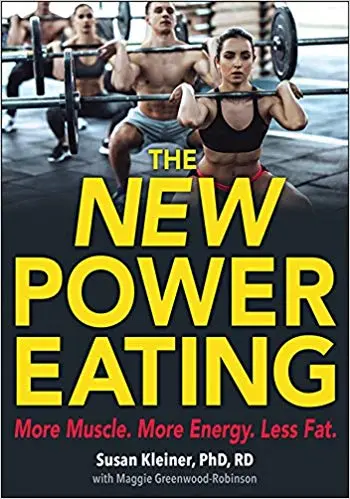
THE GOLD STANDARD IN THIRD-PARTY CERTIFICATION AND TESTING : +1-800-920-6605, info@bscg.org
By Dr. Susan M. Kleiner, PhD, RD, FACN, CNS, FISSN

Note: Some sections of the following work are excerpted from the book “The New Power Eating” by Susan Kleiner, PhD, RD, with Maggie Greenwood-Robinson (Human Kinetics, Champaign, IL), publishing in September.
There is a host of inadequacies and inaccuracies surrounding the practice of female-athlete fueling. While women and girls make up 50 percent of all sports participants only a third of all subjects in exercise science studies are female — and that percentage is likely smaller in the narrower focus of sports nutrition. This lack of research has led to inadequate nutritional recommendations and guidelines and has allowed biased marketers to drive the narrative on the dietary needs of active women and girls. While I am no longer an academic researcher, it is my hope that my voice and my pen (or keyboard) will elevate the call for more female-centric research. It is a wide-open area of opportunity.
The other way that I try to drive a wedge between marketing mumbo jumbo and evidence-based practice is by working directly with women and girls in sport on nutrition for female athletes. Based on my experiences and the growing available data, I’ve formulated models for their macro- and micronutrient needs, determined how to fuel them for training without causing gastrointestinal distress, and developed nutrition plans to meet both their performance and aesthetic goals. (You can find those models in The New Power Eating at http://www.humankinetics.com/products/all-products/New-Power-Eating-The)
Note: Some sections of the following work are excerpted from the book “The New Power Eating” by Susan Kleiner, PhD, RD, with Maggie Greenwood-Robinson (Human Kinetics, Champaign, IL), publishing in September.
There is a host of inadequacies and inaccuracies surrounding the practice of female-athlete fueling. While women and girls make up 50 percent of all sports participants only a third of all subjects in exercise science studies are female — and that percentage is likely smaller in the narrower focus of sports nutrition. This lack of research has led to inadequate nutritional recommendations and guidelines and has allowed biased marketers to drive the narrative on the dietary needs of active women and girls. While I am no longer an academic researcher, it is my hope that my voice and my pen (or keyboard) will elevate the call for more female-centric research. It is a wide-open area of opportunity.
The other way that I try to drive a wedge between marketing mumbo jumbo and evidence-based practice is by working directly with women and girls in sport on nutrition for female athletes. Based on my experiences and the growing available data, I’ve formulated models for their macro- and micronutrient needs, determined how to fuel them for training without causing gastrointestinal distress, and developed nutrition plans to meet both their performance and aesthetic goals. (You can find those models in The New Power Eating at http://www.humankinetics.com/products/all-products/New-Power-Eating-The)
The first step in coming up with a nutrition plan for female athletes is calculating their fueling needs correctly. In the past, this was done by determining energy balance—the point at which energy expenditure equals calorie input. However, being in energy balance does not always reflect an optimal state. For instance, if a female athlete has low calorie intake, she will have low energy output. Although she is in energy balance, it does not reflect her potential peak output—if she increased her caloric intake, she’d be able to expend more energy. Since our culture often tells women that less is better, energy balance is not a useful concept.
Instead, energy availability (EA) is the preferred method of calculating fueling needs. In addition to factoring in calorie input and energy output, it accounts for the calories needed to maintain fundamental physiological processes. It is expressed as: dietary energy intake (EI) – energy expended in exercise (EEE), normalized for fat free mass (kg FFM), using the leftover calories to support life processes. To obtain optimal energy availability, female athletes should take in at least 45 calories per kilogram of fat-free mass per day, and no less than 30 calories per kilogram of fat-free mass per day, at an absolute minimum.
EA = EI – EEE
Kg FFM
When female athletes’ diets are assessed by percent of total calories from macronutrients like carbohydrates, protein, and fat, the carbohydrate intake will often appear high. Yet because total energy consumption is commonly low in female athletes, their absolute carbohydrate consumption may also be low. In fact, when it comes to macronutrient needs, the largest gap in female athletes’ diets is usually carbohydrate fuel.
To address this, they should consume five to six grams of carbohydrate per kilogram of bodyweight per day when participating in moderate-intensity (off-season maintenance) training and seven to 12 grams per kilogram of bodyweight per day for high-intensity work. The carbohydrate should come from a variety of nutrient-dense sources, such as starchy vegetables, fruits, whole grains, beans, and dairy.
Whenever possible, recommendations for carbohydrate consumption may change based on what phase of the menstrual cycle a female athlete is in. In particular, during the luteal phase—which begins after ovulation, lasts about 14 days (unless fertilization occurs), and ends just before a menstrual period—studies have shown that carbohydrate oxidation is reduced at rest and at moderate-intensity exercise levels. So there may be a reduced need for carbohydrate intake during rest days and steady-state training days in this phase.
Protein needs are also linked to energy availability for female athletes. When energy levels are high, protein is used primarily for physiological functions that require nitrogen, such as the structure, function, and regulation of the body’s tissues and organs. During periods of low energy availability, protein is used to meet energy needs by removing and excreting nitrogen as urea from the urinary tract, and when a female athlete is in an energy deficit, protein needs increase to fulfill energy requirements.
The balance needed between protein, carbohydrate, and energy availability is particularly profound for women in sport because female reproductive hormones are linked to the metabolic pathway. When energy and/or carbohydrate and protein intakes are deficient, reproductive function declines. This has a domino effect on overall health, leading to diminished thyroid function, bone mineral metabolism, immune function, gastrointestinal function, and maintenance of body tissues and organs. Ultimately physical performance declines.
To maintain adequate protein levels, female athletes should take in high-performance, nutrient-dense sources of protein such as meat, fish and seafood, eggs, dairy, vegetable proteins, grains, beans, nuts, and seeds. However, it is very difficult for women and girls in sport to eat enough to fully meet their daily protein needs, so the recommendations listed below have a built-in margin of safety to account for the likelihood that energy consumption will often, if not always, be insufficient. When athletes are in energy deficit, increase protein intake by 10 percent:
Female athletes need fat to support conditioning, recovery, tissue growth, and joint mobility, as well as immune, reproductive, endocrine, and nervous system functions. Fat intake should comprise 25 to 35 percent of their total daily energy intake, and female athletes should stick to “high-performance” fats, such as those found in fatty fish, nuts and seeds, nut and seed butters, avocados, olives, extra virgin olive oil, and other vegetable oils.
Regarding micronutrient needs, decades of research have shown that female athletes are at a high risk of iron deficiency. They also frequently lack in calcium and vitamin D. All of these factors will impact their performance and overall health.
The best food sources of iron are dark meats and oysters, while calcium can be found in dairy products. Green, leafy vegetables are great sources for both iron and calcium. For vitamin D, being out in the sun with face, arms and legs exposed without sunscreen for 15 minutes between the months of April to September can help address the deficiency, as well as consuming fortified dairy products and fatty fish. Additionally, to ensure micronutrient needs are met, it may be a good idea to supplement female athletes’ diets with 18 mg iron, 1,000 mg calcium, and 2,000 IU vitamin D per day (can be lowered with sun exposure during summer months).
Structuring a day’s worth of food for women and girls in sport should focus on eating a plant-rich diet, with plenty of vegetables, fruits, grains, beans, nuts, and seeds. Each meal should contain two or more servings of plant foods, one to two servings of high-performance fats, and one serving of a protein-rich food. I encourage two to three dairy servings throughout the day, especially following training to enhance rehydration and recovery.
Finally, female athletes will need to consume snacks between meals to maintain optimal nutrient and energy levels. A good snack combines foods rich in carbohydrate, protein, and fat. Pre-workout snacks should be very low in fat and moderate in protein to allow the stomach to empty quickly.
All female athletes want to enhance physical performance, and the best nutritional strategy to support this goal is to fully fuel training by consuming carbohydrate before, during, and after activity. However, doing so without causing gastrointestinal (GI) distress can be difficult for female athletes, as surveys show higher levels of GI discomfort during training in this population.
The recommended carbohydrate intake to fuel an athletic workout is 1.2 grams per kilogram of bodyweight per hour. This is ideal in theory, but in practice, female athletes struggle to eat this much food and still be empty enough to feel comfortable while training. Many have cited this problem as a significant reason to consume less carbohydrate prior to a workout, which could negatively impact performance.
My solution is to use carbohydrate supplementation, and I recommend Vitargo (www.vitargo.com) for my female clients. The ingredient Vitargo is a unique, patented, fractionated amylopectin (starch) that has 20 years of research supporting its effectiveness and has received third-party certification from BSCG. Moreover, I’ve used it with clients for many years, and none have ever reported experiencing GI distress, bloating, or cramping.
Limiting carbohydrate supplementation to 60 grams per hour during training has been shown to decrease the likelihood of GI upset with standard carbohydrate supplements. Yet I know female triathletes who routinely take 70 to 100 grams per hour of Vitargo during workouts without GI discomfort.
Despite the potential GI issues that can come with fueling before practice, I never recommend female athletes train in a fasted state—even when they have workouts very early in the morning. If they cannot eat enough to be fueled yet comfortable, I recommend they take a pre-practice carbohydrate supplement at 1 to 1.2 grams per kilogram of their bodyweight. This dosage should provide enough energy for them to train without upsetting their stomachs. Here again, Vitargo will alleviate any possibility of GI upset. To fuel workouts that last longer than 90 minutes, athletes can easily re-fuel with Vitargo during their workout continuously. Vitargo has also been shown to enhance glycogen recovery better and faster than other carbohydrate supplements.
In addition to their goal of improving performance, female athletes may have a competing desire to change the way their bodies look to meet a certain standard. The influence of peers, coaches, and the media is profound in this regard, as are images from the weight loss and fashion industries that promote a lean, sculpted physique. It is important to acknowledge this propensity in female athletes and work to understand their concerns.
Getting photo-shoot ready in the off-season typically will impact training in a negative way, but there is time to recovery any training losses. Getting photo-shoot ready in the middle of a competitive season is very difficult, and not advisable. However, there are occasions when “threading the needle” between the competing goals of ripped abs and highly competitive physical game or match performance occur. These situations require exact diet planning by the sports nutritionist and diligent execution from the athlete. The diet should still fully fuel around the athlete’s play, but some restriction will occur during meals and snacks outside of training fuel. I have found that in fit athletes, the diet only takes 5 to10 days to prep for a photo shoot, and then the athlete returns to their regular in-season diet plan. By continuing to fully fuel training, and even adding more training fuel to the program and staying in very close contact with the athlete, I have successfully supported female athletes through competitive play and photo-shoot prep.
Some female athletes may turn to constant calorie restriction to help reach their aesthetic goals, and this should be an immediate red flag. Concerted under-fueling and diminished carbohydrate consumption by athletically active women can deplete body fat stores to unhealthy levels, which elevates the risk for developing the female athlete triad. This refers to three interrelated health problems seen in women: disrupted eating habits, menstrual irregularities, and weak bones. Recently, researchers have added low energy availability, high fiber, and restricted carbohydrate consumption as additional risk factors for the female athlete triad. Girls and women who demonstrate these behaviors should be referred to a physician.
When sports nutrition is catered to their specific requirements, female athletes can thrive. By ensuring they are meeting their macro- and micronutrient needs, helping them fuel to train, and addressing any body consciousness, you can help them reach optimal performance.
Female athletes have lower sweat rates than their male counterparts, generally due to their smaller body masses and lower metabolic rates. Because they typically lose less fluid in hot-humid environments, they are at a decreased risk of dehydration.
However, recent research does call attention to females’ increased risk of hyponatremia, a condition in which sodium levels in the blood are too low. The reasons for this are likely multiple, due in part to their smaller body size, altered sweat rates, and behavioral factors, such as a propensity to drink more water.
To prevent hyponatremia during training, female athletes should drink 0.4 to 0.8 liters of fluid per hour, although recommendations for fluid consumption are broad and should be individualized to the sweat rate of each athlete. Endurance athletes in particular should choose fluids containing carbohydrate and an appropriate mix and level of electrolytes—depending on their training status, sweat rates, weather, and event—to prevent overhydration.

 YouTube Channel
YouTube Channel
Oliver Catlin Interview
 BSCG BLOG
BSCG BLOG
Magic Mushroom Supplements as Seen Through a Google and Amazon Lens

 The Catlin Perspective blog widget
The Catlin Perspective blog widget
THE HISTORY OF BSCG